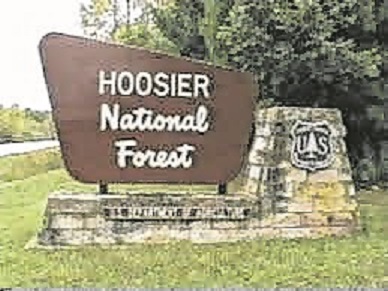
Monroe County commissioners and environmental organizations have filed a lawsuit seeking to block the U.S. Forest Service’s implementation of the Houston South Vegetation Management and Restoration Project in the Hoosier National Forest.
This lawsuit, filed in the U.S. District Court for the Southern District of Indiana, is the third lawsuit local government and environmental organizations have filed against related to the Houston South project. The other plaintiffs are the Indiana Forest Alliance, the Hoosier Environmental Council and the Friends of Lake Monroe.
In August, the Forest Service issued a final supplemental environmental assessment for the Houston South Vegetation Management and Restoration Project. That assessment may be viewed at fs.usda.gov/project/hoosier/?project=64831. According to the assessment, the purpose of the project is to “promote tree growth, reduce insect and disease levels and move the landscape toward desired conditions.”
The majority of the project area is in the northwest corner of Jackson County on the Brownstown Ranger District of the Hoosier National Forest, with a small portion overlapping the northeast corner of Lawrence County.
Chris Thornton, Brownstown District ranger for the Hoosier National Forest, said he could not comment on any pending litigation.
In the past, he said the long-term health of the forest ecosystem and its ability to provide the many things the Forest Service expects and needs from it including diverse wildlife habitat, carbon sequestration and storage, clean water and sustainable recreational opportunities are at the core of his decision to propose this project move forward.
In the previous lawsuits, the court found Forest Service violated the National Environmental Policy Act (NEPA) and ordered the Forest Service to examine the project’s impacts to Lake Monroe, according to this new lawsuit filed Sept. 11 with the New Albany Division.
That lawsuit further contends the Forest Service has ignored these court orders and is attempting to push forward with the project as is, without any changes to the project design.
“Lake Monroe is the sole drinking water source for 145,000 people and a major recreational resource for Monroe County and the entire state of Indiana. We need to improve water quality in the lake, not degrade it.” said Sherry Mitchell Bruker, resident of the Friends of Lake Monroe.
Monroe County Board of Commissioners President Julie Thomas said this new lawsuit is necessary to stop the destructive impact this project would cause to Lake Monroe and the surrounding area.
“Once again, we are forced to take the Forest Service to court for failing to examine the impact this destructive project will have on Lake Monroe,” Thomas said. “The Forest Service is trying to log, burn, build roads through and spray pesticides on thousands of acres of exceedingly steep, hilly ground, just as they first proposed back in 2018, without a single change or any data or information indicating the project will not harm Lake Monroe and public health.”
In addition to the USFS’s failure to properly examine the impacts to Lake Monroe, the lawsuit claims the Forest Service is violating NEPA by failing to complete an environmental impact statement (EIS) for the Houston South Project, which is the largest logging and burning project in the history of the HNF.
“The sheer size of the project, its potentially major adverse impact on the largest municipal surface water supply in southern Indiana, its destruction of endangered bat habitat, and clear contravention of President Biden’s Executive Order 14072 to protect mature and old-growth forests necessitate that an EIS be prepared to examine less harmful alternatives to the project,” said Hoosier Environmental Council Senior Policy director David Van Gider.
“If the Forest Service had their way, the solitude and serenity of an island of wild nature found nowhere else in the entire lower Midwest, will be shattered by a roaring hellscape of chainsaws, bulldozers, skidders and feller bunchers for the next 12 years and potentially longer,” said Indiana Forest Alliance Executive Director Jeff Stant. “These impacts and the USFS’s repeated efforts to ignore court orders are a betrayal of the public’s trust and increase the urgency to stop this destructive project before it begins.”
The full text of the Sept. 11, 2024 lawsuit can be found here.
The final assessment states there is a need to reduce the amount of pine in the project area to provide more suitable habitat to a wider array of wildlife species. As maturing oaks and hickories age and die, they are being replaced by trees that do not provide crucial food sources for a wide array of wildlife.
“The project area is experiencing a steady decline in forest health as stressors such as overcrowding, more periods of drought, higher temperatures, and more storms with higher winds make trees more susceptible to pests and pathogens,” Forest Supervisor Mike Chaveas said. “The area has already suffered losses from ‘oak decline’ and there is a high likelihood that it will continue to kill more trees due to the continuing stress of drought and stands that are too dense.”
The Forest Service proposes to conduct approximately 1,104 acres of even-aged management, 2,405 acres of thinning in both pine stands and hardwoods, and 462 acres of selection harvest in hardwood stands, as stated in the assessment. Also, approximately 234 acres are proposed for midstory removal treatments.
While there have been a variety of opinions about the project aired at public meetings, Thorton said he is certain that the project is the best step forward for the area.
“We are confident that the actions proposed in this project will not cause harm to our water sources, wildlife, or any other resource,” Thornton said. “On the contrary, these actions are critical to the long-term well-being of the watershed as a whole and the wildlife that depend on the habitat within it.”
